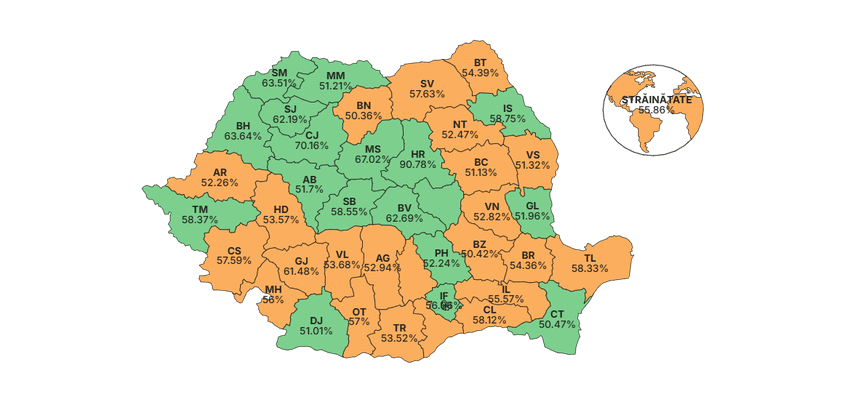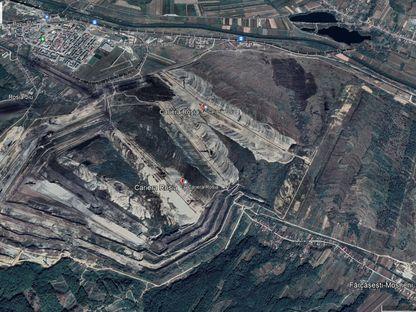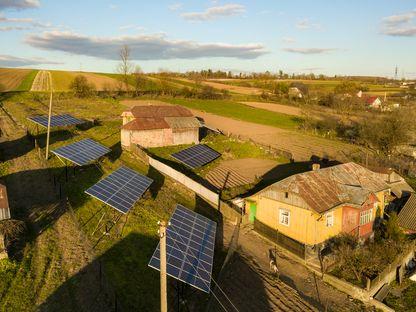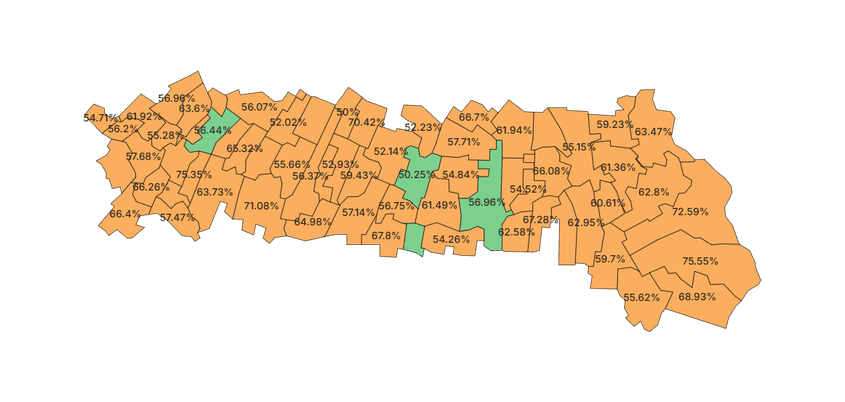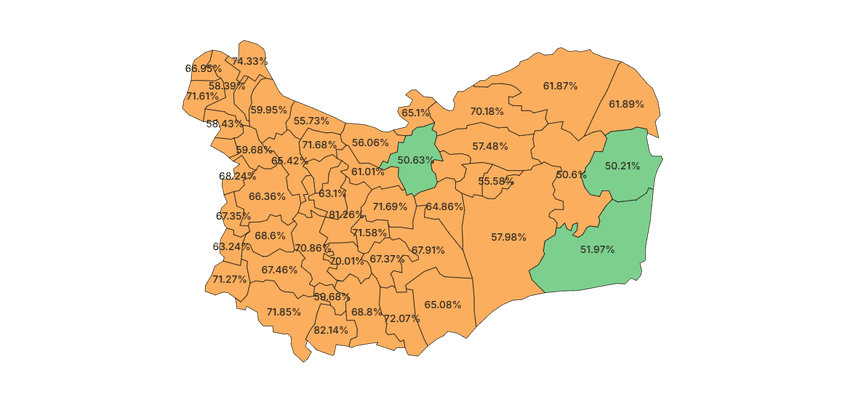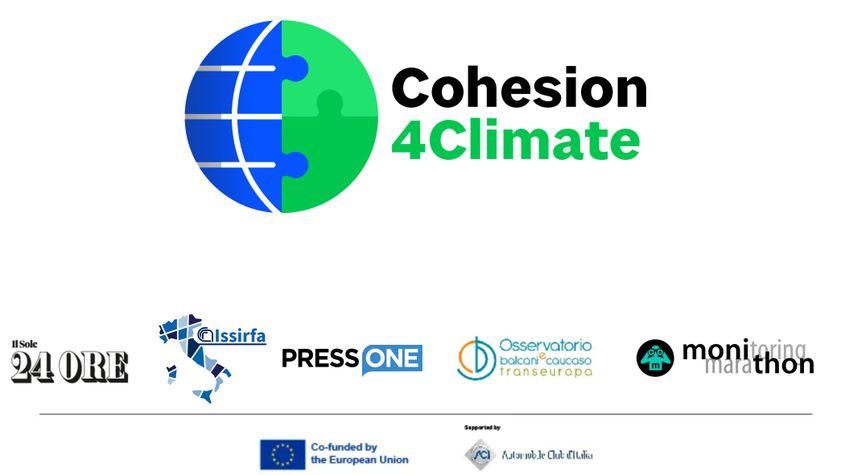Șantierul Șoselei de Centură București-Sud (A0 SUD), lotul 2, din București. Foto: Inquam Photos / George Călin
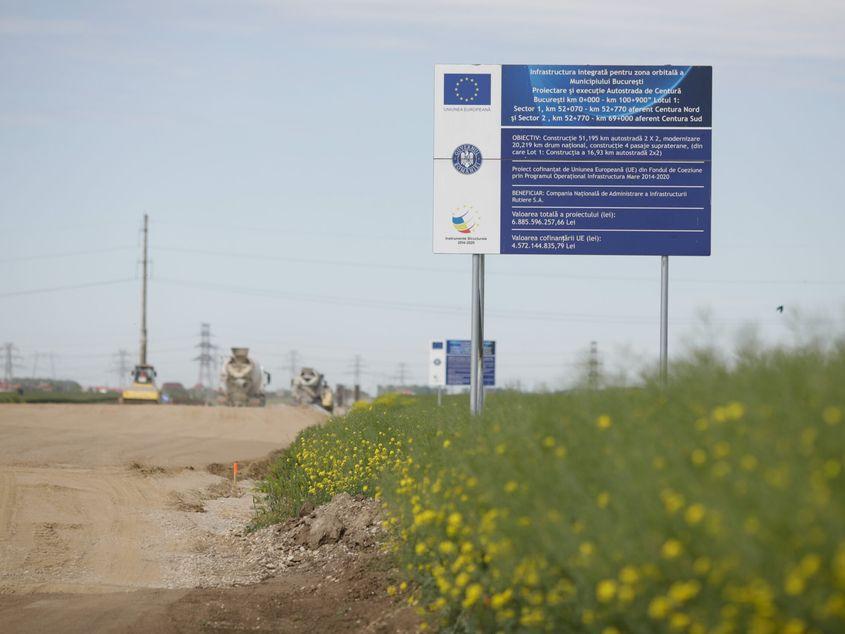
Șantierul Șoselei de Centură București-Sud (A0 SUD), lotul 2, din București. Foto: Inquam Photos / George Călin
04/06/2025
Extremism vs. poverty: The map of disadvantaged areas where Nicușor Dan clearly lost the elections. How much EU money reached Romania’s “sovereigntist” communities
"Sovereigntist" Romania is gathered in nine counties where the AUR candidate, George Simion, won over 55% of the votes in the May presidential elections. All nine of these counties belong to Romania’s „disadvantaged areas,” for which the European Union allocates cohesion funds meant to support development and raise living standards in order to reduce regional disparities.
- 7 out of the 9 counties where Simion received over 55% of the votes have attracted the least amount of EU cohesion funds in the past 11 years;
- Despite being among the top counties in EU funding absorption, Tulcea and Suceava also voted for Simion;
- Disadvantaged areas are defined as those where the population’s income is below 75% of the EU’s per capita GDP average.
Although Nicușor Dan is officially the President of Romania, the voting map from the second round of the presidential elections reveals the existence of a „Deep Romania,” a profoundly „sovereigntist” Romania, concentrated in nine counties where George Simion won decisively, with over 55% of the vote.
These counties are: Gorj (Simion: 61.48%), Tulcea (58.33%), Călărași (58.12%), Caraș-Severin (57.59%), Suceava (57%), Olt (57%), Giurgiu (56.01%), Mehedinți (56%), Ialomița (55.57%).
If we overlap the electoral map with the map of EU cohesion funds absorbed in Romania’s disadvantaged regions, we see that seven of these nine counties — Călărași, Ialomița, Giurgiu, Olt, Gorj, Caraș-Severin, Mehedinți — rank at the bottom in terms of EU funding absorption between 2014 and 2020 (with extensions through 2023/2024).
On the other hand, Suceava (57% for Simion) and Tulcea (58.33% for Simion) are actually among the top-performing counties attracting EU cohesion funds.
Nicușor Dan stated in an interview with CNN that the rise of far-right parties, at least in Romania, has more of a social explanation than an ideological one.
This „social explanation” is grounded in reality: most counties where George Simion decisively beat Nicușor Dan in the presidential election are the very same where the least EU funding for cohesion and regional development has been absorbed.
As a case study, let’s take 2 such counties: Gorj (61.48% Simion) and Ialomița (55.57% Simion).
Mulți ne citesc, puțini ne susțin. Fără ajutorul tău, nu putem continua să scriem astfel de articole. Cu doar 5 euro pe lună ne poți ajuta mai mult decât crezi și poți face diferența chiar acum!
Gorj: Over 200 projects from cohesion funds, but only a couple of them for infrastructure or better standards of living
The electoral map of Gorj is entirely orange, with only one exception: the commune of Arcani, where Nicușor Dan won (54.82% vs. Simion’s 45.18%).
Results of the second round of the presidential elections in May 2025 in Gorj County. Photo: roaep.ro
In the past 11 years, Gorj has absorbed €354.77 million in cohesion funds, below the national average. These funds covered 252 projects, most of which came through Regional Operational Programs (ROP) and the Large Infrastructure Operational Program (LIOP).
This equates to an average of around €32 million per year, for the entire county.
Coal Mining Expansion Leads to Deforestation: Over 470 Hectares of Forest Cut Down in Gorj, Romania
Over the past six years, more than 470 hectares of national forest land have been allocated by the government, without compensation, to the Oltenia Energy Complex (CEO) for the expansion or opening of new coal mines.
The not-so-green Romania. The state delays settlements for photovoltaic panels by 2 years
PressOne reviews the main dysfunctions in the production, consumption and distribution of energy from renewable sources, as revealed by discussions with consumers and data provided by official sources at the request of our editorial office.
Upon reviewing the 252 projects, we see that most of them focused on modernizing or buying equipment for local businesses and „managing the COVID-19 crisis” (a trend seen across Europe).
One-third of the EU funds were spent on local infrastructure projects: €55.41 million for the ”construction of infrastructure that would allow the bypass of the Târgu Jiu area”, €21.38 million for the ”expansion and modernization of public transport (trolleybus)”,€18.82 million for modernizing county road DJ675C, another €15.42 million for modernising DJ675B and €7.82 million for rehabilitating DJ671B.
No fewer than 15 projects were implemented in the town of Rovinari (where Simion received 77.42% of the vote). Only six of those directly targeted improving living conditions: two apartment buildings renovations, one social housing construction project, one kindergarten rehabilitation and two projects for public transport and street lighting modernization.
Un newsletter pentru cititori curioși și inteligenți.
Sunt curios
Ialomita: Nicusor Dan won in Slobozia and Urziceni, where major EU infrastructure projects were approved. The rest of the county is pro-Simion
In Ialomița, the pattern is similar. In the last 11 years, only 140 local projects were implemented, totaling €220.6 million.
Results of the second round of the presidential elections in May 2025 in Ialomita County. Photo: roaep.ro
A total of €53.95 million were spent on two county road modernization projects.
Another €13 million went to two separate public transport projects in Slobozia, where Nicușor Dan received 56.96% of the vote versus Simion’s 43.04%.
In Slobozia, another 4 million euros were granted through two projects dedicated to the modernization of the county’s emergency hospital.
4.86 million euros were allocated for „community development” in the Valea Ciorii commune (Simion: 67.79% vs. Dan: 32.21%).
Another 2.69 million euros in cohesion funds were spent on the rehabilitation of Urziceni Hospital (in Urziceni, Nicușor Dan won over 56% of the vote).
1.01 million euros were also allocated in Ialomița for a vocational training program for 411 unemployed young people aged 16–29.
Similar patterns can be seen in Tulcea and Suceava, counties that voted largely for Simion, while the pro-Nicușor Dan vote came from county capitals and larger towns, which also benefited from the majority of infrastructure projects (road rehabilitation, hospitals, schools, public transport, etc.).
In Tulcea, for example—a county that ranks third nationally in terms of cohesion fund absorption—the vast majority of those funds were spent on programs to „improve SME competitiveness” and for the purchase of goods and equipment for local businesses.
€1.96 million in cohesion funds were spent on „integrated measures in disadvantaged schools” for ”quality education services” and ”programs to prevent early school dropout.”
Another €1.38 million was spent on building a furniture factory in the region, and €230,000 went toward ”modernizing the water supply system in the commune of Smârdan.”
What are disadvantaged areas, and how are they defined for EU cohesion funding?
As Pressone has previously shown, „cohesion funds” is the umbrella term for European investment programs meant to help Romania reduce the gap between poorer and more developed areas. These include: the European Regional Development Fund (ERDF) – for closing regional development gaps, the European Social Fund (ESF) – focused on social development and impact, the Cohesion Fund and the Just Transition Fund.
During the 2014–2020 funding period (used here to correlate with the 2025 presidential election results), Romania had an absorption rate of 93.23%.It should be noted that this figure includes extensions—some funding continued through 2023–2024.
According to the European Commission, the „regional aid map” for Romania defines the areas eligible for investment aid.
In Romania’s case, regions covering 89.34% of the population are eligible. This includes seven regions (North-West, Center, North-East, South-East, South-Muntenia, South-West Oltenia, and West) which are among the most disadvantaged in the EU, with GDP per capita below 75% of the EU average.In addition, 28 municipalities in the Ilfov area are also eligible.
A complete and transparent picture of Romania’s current cohesion fund status can be viewed on the European Commission’s official website.
Romania has a €44 billion cohesion fund budget to spend by 2027
From the 2021–2027 funding period, Romania has absorbed less than 10% of its allocated EU funds so far. More exactly, the Minister of Investments and European Projects, Marcel Boloș, stated that Romania has absorbed 9.4% of the allocated funds so far.
„Our goal is to close May with €1.8 billion sent to the Commission, and likely receive them by the end of June or early July. We also have a new batch of payment applications scheduled for July, worth around €1.5 billion, so that we receive another installment from the Cohesion Policy, which holds more funds than the National Recovery and Resilience Plan,” said Boloș.
Boloș explained that Romania has €30 billion allocated under the Cohesion Policy for 2021–2027. To this, Romania must add €14 billion in national co-financing.
„The total budget to be managed is €44 billion. These funds must be spent by December 31, 2029.They come in addition to the National Recovery and Resilience Plan (NRRP), and that's why the absorption of this significant amount remains a priority, alongside the NRRP, for Romania’s development and modernization,” stated Marcel Boloș.
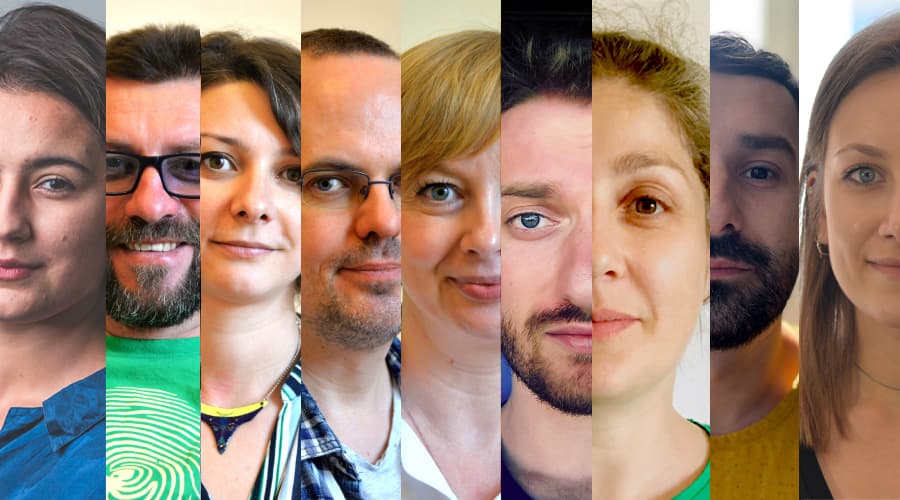
Avem nevoie de ajutorul tău!
Mulți ne citesc, puțini ne susțin. Asta e realitatea. Dar jurnalismul independent și de serviciu public nu se face cu aer, nici cu încurajări, și mai ales nici cu bani de la partide, politicieni sau industriile care creează dependență. Se face, în primul rând, cu bani de la cititori, adică de cei care sunt informați corect, cu mari eforturi, de puținii jurnaliști corecți care au mai rămas în România.
De aceea, este vital pentru noi să fim susținuți de cititorii noștri.
Dacă ne susții cu o sumă mică pe lună sau prin redirecționarea a 3.5% din impozitul tău pe venit, noi vom putea să-ți oferim în continuare jurnalism independent, onest, care merge în profunzime, să ne continuăm lupta contra corupției, plagiatelor, dezinformării, poluării, să facem reportaje imersive despre România reală și să scriem despre oamenii care o transformă în bine. Să dăm zgomotul la o parte și să-ți arătăm ce merită cu adevărat știut din ce se întâmplă în jur.
Ne poți ajuta chiar acum. Orice sumă contează, dar faptul că devii și rămâi abonat PressOne face toată diferența. Poți folosi direct caseta de mai jos sau accesa pagina Susține pentru alte modalități în care ne poți sprijini.
Vrei să ne ajuți? Orice sumă contează.
Share this


